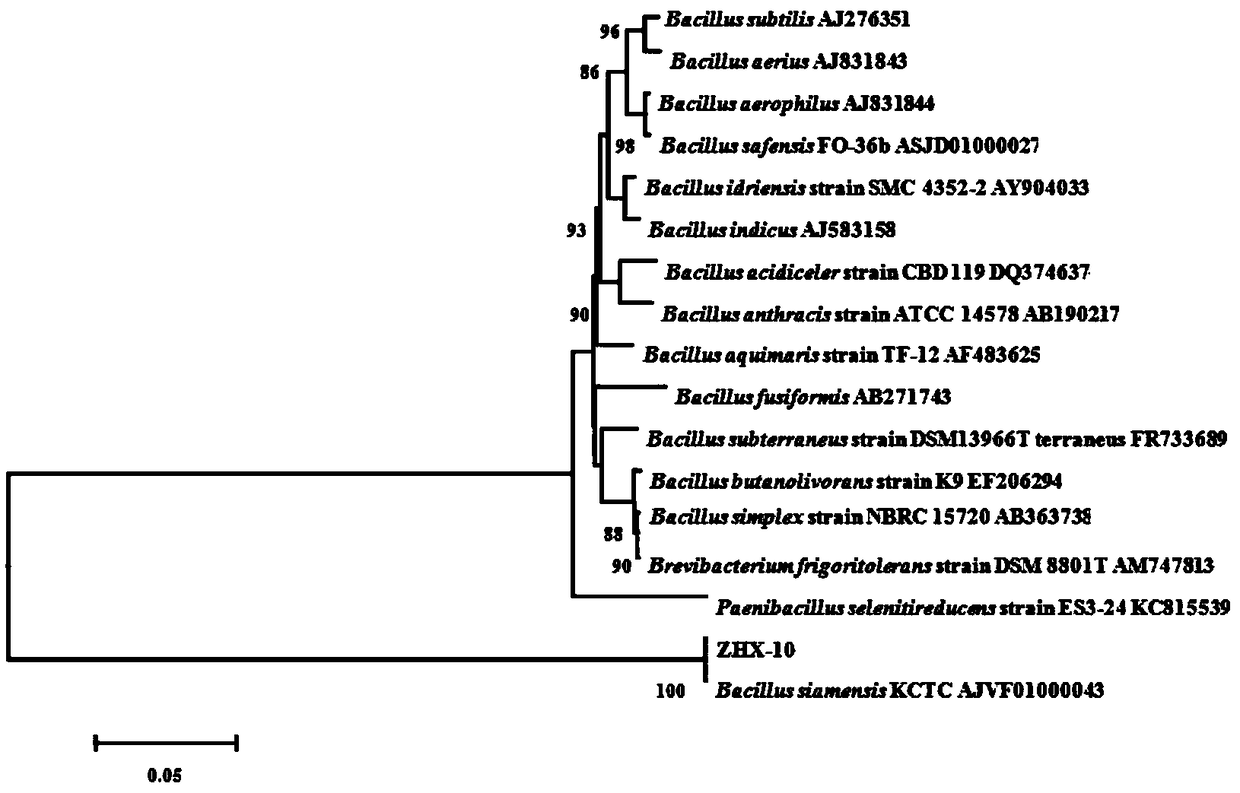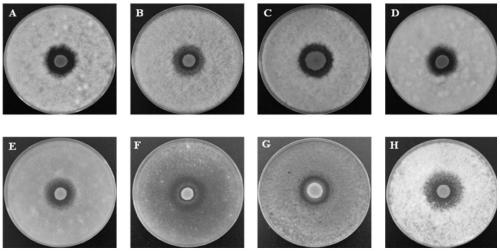Bacilus siamensis, and application thereof in prevention and control of root rot and southern blight diseases
A technology for bacillus and root rot, applied in the field of microorganisms, can solve the problems of single control target, slow onset of effect, unstable control effect, etc., and achieve the effect of large reproduction number and fast growth speed
- Summary
- Abstract
- Description
- Claims
- Application Information
AI Technical Summary
Problems solved by technology
Method used
Image
Examples
Embodiment 1
[0021] Screening and Identification of Example 1 Bacterial Strains
[0022] (1) Isolation and purification of strains
[0023] In the plots where peanut soil-borne diseases are serious, about 100 g of soil samples from the depth of 5 to 10 cm from the surface were weighed around the rhizosphere of diseased and healthy plants, brought back to the laboratory, and stored at 4 °C. Take 10g of the collected soil sample and add it to 90mL sterile water, shake it at 28°C and 140rpm for 15 minutes, let it stand for 5 minutes, take the supernatant, and use the 10-fold serial dilution method to successively dilute to 10 -2 、10 -3 、10 -4 and 10 -5 , 200 μL of each concentration was applied on the LB solid medium, and the coating was uniform. Each concentration was repeated 3 times, and the plate was inverted and incubated at 28°C. When bacterial colonies appear on the culture medium, the spore suspension of Colletotrichum candidum is sprayed. After culturing for 1 day, select the co...
Embodiment 2
[0033] The mensuration of embodiment 2 strain ZHX-10 antibacterial activity
[0034] (1) Pick a single colony of ZHX-10 with a toothpick and put it into a conical flask filled with 15mL of nutrient broth medium, shake and culture at 150rpm at 28°C for 14-16h, centrifuge at 5000rpm for 5min to collect the bacteria, and use ddH 2 O resuspension preparation concentration is OD 420 =0.3 bacterial suspension. Take 10 μL of bacterial suspension and inoculate it in the center of PDA solid medium with a diameter of 9 cm. After the bacterial solution is fully absorbed, incubate at 28°C for 24 hours. OD was then sprayed into the PDA medium 420 =0.3 Peanut root rot (Neocosmosporavasinfecta), peanut root rot (Fusarium verticillioides), soybean root rot (F.oxysporum), cucumber root rot (F.solani), wheat scab (F. graminearum), Pepper root rot (F. solani), corn ear rot (F. proliferatum), sugarcane tip rot (Gibberella fujikuroi) spore suspension. Incubate in the dark at a constant tempera...
Embodiment 3
[0036] The bacteriostasis of embodiment 3 fermented liquid to the white silkworm
[0037] Pick a single colony of ZHX-10 with a toothpick and put it into a conical flask filled with 40mL of nutrient broth medium, culture it with shaking at 28°C for 14-16h, centrifuge at 10,000rpm for 10min, collect the supernatant, and filter it with a 0.22μm filter membrane to obtain sterile culture medium. Mix the sterile culture filtrate with the PDA medium heated and cooled to 40-50°C at a ratio of 1:10 and pour it onto the plate, insert a 8mm-diameter bacterial cake of E. albicans in the center of the plate, cultivate it at 25°C, and measure the colonies after 72 hours diameter. The plate added with the same amount of broth medium was used as a control, and 6 replicates were set up for each treatment, and the colony diameter was measured by the cross method. As a result, it was found that the fermented liquid of bacterial strain ZHX-10 had significantly reduced the growth of the bacteri...
PUM
 Login to View More
Login to View More Abstract
Description
Claims
Application Information
 Login to View More
Login to View More - R&D
- Intellectual Property
- Life Sciences
- Materials
- Tech Scout
- Unparalleled Data Quality
- Higher Quality Content
- 60% Fewer Hallucinations
Browse by: Latest US Patents, China's latest patents, Technical Efficacy Thesaurus, Application Domain, Technology Topic, Popular Technical Reports.
© 2025 PatSnap. All rights reserved.Legal|Privacy policy|Modern Slavery Act Transparency Statement|Sitemap|About US| Contact US: help@patsnap.com



